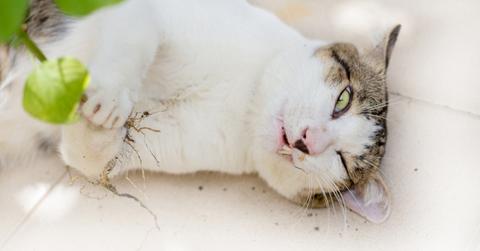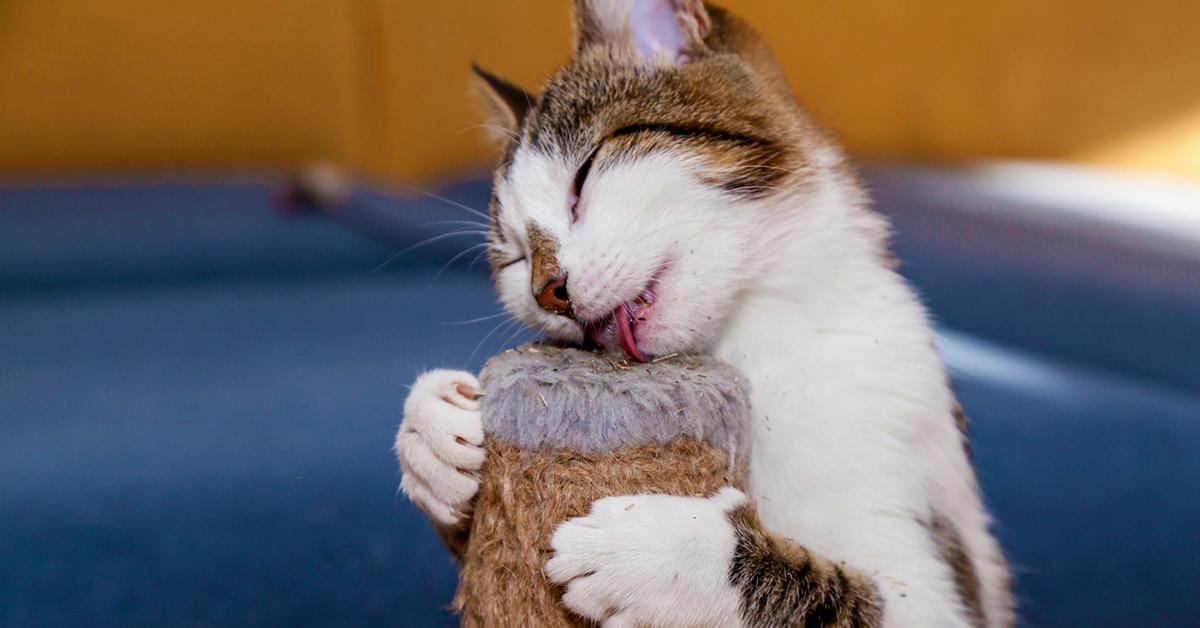Why Does Catnip Make Cats High?
Find out why your cat goes so crazy for catnip!
Updated July 10 2020, 1:25 p.m. ET

Whatever the cat has, we want some of that! No, but seriously, if you have ever seen a cat enjoying the pleasures of catnip, it may look similar to the Cheshire Cat, as in, a crazed cat who appears to be experiencing euphoria. While it’s certainly entertaining for the humans (and no doubt, for the cat) many cat-owners want to know more about why catnip affects cats the way it does, if it’s safe, and how much catnip is too much catnip.
Catnip is actually a plant — a shrub that falls into the mint family called Nepeta cataria. While it was native to Europe and Asia, it now also grows wild in the U.S., according to Vox. In fact, it might even be growing in your backyard.
But despite it being commonplace, catnip is highly coveted by animals, particularly the animals for which it's named.
Keep reading for more info on why catnip makes cats high and other answers to your catnip-related questions!
Do cats actually get high from catnip?

Yes. In fact, that hilarious scene from Shrek 2 comes to mind: Puss in Boots (who is obviously a cat voiced by Antonio Banderas) is stopped by police and they find catnip on him and take it into custody. It’s a funny scene that probably only the adults understood, but it’s based in truth.
While catnip — and the possession of catnip — is not illegal, it is — for all intents and purposes — a psychoactive drug. Maybe not for humans, but certainly for cats.
Why does catnip make cats high?
Because it’s a drug! No, but seriously, cats get high off of catnip thanks to the chemical nepetalactone, which catnip produces in its teeny-tiny bulbs. According to Scientific American, these bulbs (and therefore, the chemical) coat the leaves, stems, and seedpods of catnip. When touched, these bulbs rupture, therefore releasing nepetalactone. Cue cat euphoria!
Why does catnip make cats go crazy?
Cats inhale the essential oil nepetalactone, which then binds to the receptors inside a cat’s nose. These receptors work in tandem with sensory neurons in a cat’s brain.
According to Vox, “This appears to alter activity in several areas of the brain, including the olfactory bulb, the amygdala, and the hypothalamus. This last area, among other things, is involved in regulating the animal’s emotions.”

With the hypothalamus and other areas of a cat’s brain inhibited by the nepetalactone, a cat is likely to act intoxicated.
When first introduced to catnip, a cat might sniff it, rub their face in it, drool, and roll in the catnip. During this first phase of catnip – the phase that is most often described by cat owners as the cat “going crazy” — a cat can appear to be euphoric. This may present itself in a similar way to how “queens in season” or “females in heat” react, Scientific American explains.
“They may rub their heads and body on the herb or jump, roll around, vocalize, and salivate,” according to Scientific American. “This response lasts for about 10 minutes, after which the cat becomes temporarily immune to catnip’s effects for roughly 30 minutes.”
In short, catnip causes most cats to “go crazy” because they are experiencing euphoria.
Does catnip make cats hallucinate?

While catnip can certainly cause a cat to feel high and experience a type of euphoria, Dr. Nancy Dunkle, founder of Exclusively Cats Veterinary Hospital in Medford, N.J., told PetMD that it is not comparable to the effect or ways in which humans experience drug use or addiction. Particularly, cats do not hallucinate while using catnip.
“They aren’t hallucinating,” Dr. Dunkle explained. “They’re aware of their surroundings. They are just ‘much happier’ about everything. So, it’s not something that you should avoid with your cat due to a drug or bad habit stigma.”
There you have it: The answer to your most important question! Can a cat develop a drug problem with catnip? No!
Can too much catnip kill a cat?
Or, alternatively, can too much catnip hurt a cat? Catnip is a natural essential oil and it does not contain any ingredients that can kill a cat or cause a cat to overdose.
That being said, there is such a thing as too much catnip. Too much catnip will most likely not present itself in a way that can harm your cat. It may just result in a stomachache if a cat ingests too much catnip.
And nobody, not even a high cat, wants a stomachache.
Is catnip safe for kittens?
Catnip will only be effective for cats who have started reaching their sexual maturity. This is because catnip actually mimics a cat’s own sex pheromones. It causes a similar response to females in heat because of its ability to mimic sex pheromones. (Though don’t worry, your male cat will enjoy catnip, too.)
For this reason, most cats don’t experience the effects of catnip until they are at least six months old.
Can catnip affect dogs?
Catnip is safe for dogs, but it typically has the opposite effect on dogs that it does on cats. For cats, catnip is considered a stimulant — at least for 10 minutes before it calms them down into a zen-like state. But for dogs, catnip is more of a sedative.
Because of its ability to calm down dogs, catnip is most often used with dogs who have anxiety, trip anxiety, or struggle with loud sounds like thunderstorms or fireworks. According to The Nest, catnip can be safely used on dogs by adding catnip leaves to their water. If you prefer to use dried catnip, add anywhere from 1/8 to ½ teaspoon per pound of dog food.
Catnip, in dogs, has some other uses, too. It can be used as a diuretic, as in dogs, catnip oil usually causes dogs to urinate more. Catnip can also soothe a dog’s intestinal issues. It can effectively relieve gas, soothe a dog’s stomachache, reduce cramps, reduce spasms, and curb diarrhea.
If you are considering giving your dog catnip, consult your veterinarian first. While animals generally cannot overdose on catnip, too much catnip can cause intestinal issues. Be sure to speak with your vet first to ensure you are giving the proper amount of catnip.